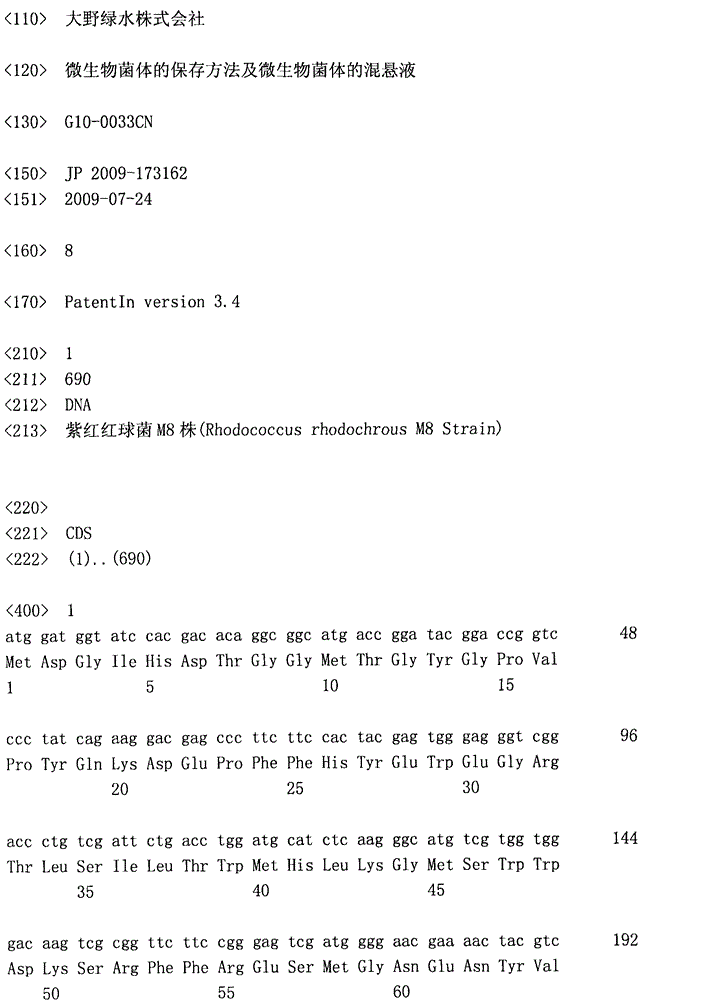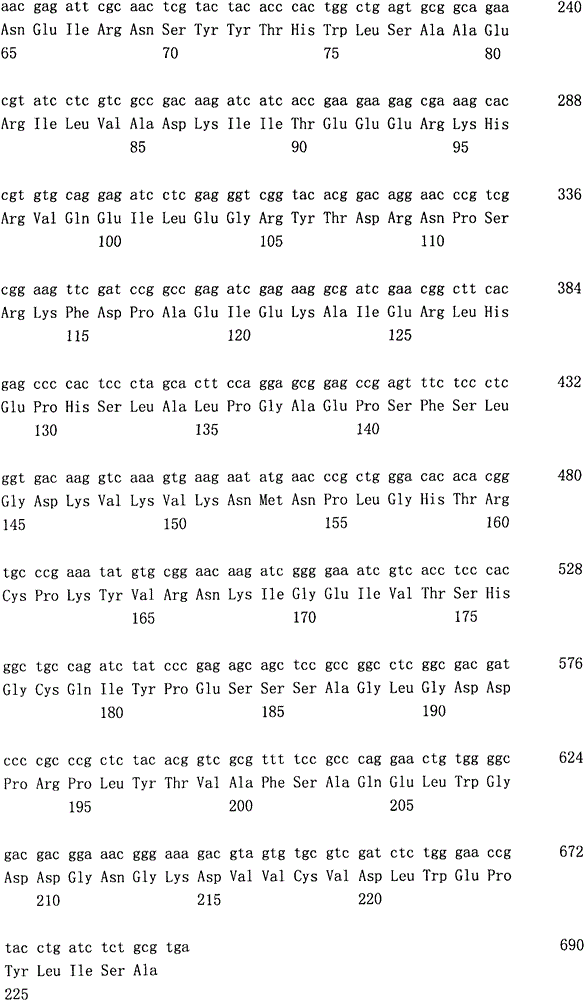Preservation method of microbial cells and suspension of microbial cells
A technology of microorganisms and preservation methods, applied in microorganism-based methods, biochemical equipment and methods, microorganisms, etc., can solve problems such as loss or reduction of microbial enzyme catalytic ability, and achieve the effect of reducing labor and cost
- Summary
- Abstract
- Description
- Claims
- Application Information
AI Technical Summary
Problems solved by technology
Method used
Image
Examples
Embodiment 1
[0035] Embodiment 1 (room temperature preservation)
[0036] to cultivate
[0037] Prepare 100ml of culture medium (PH7.0) containing 2% glucose, 1% urea, 0.5% peptone, 0.3% yeast extract, and 0.05% cobalt chloride in a 500ml Erlenmeyer flask, and sterilize at 121°C in an autoclave 20 minutes. In this medium, Rhodococcus rhodochrous J-1 strain (Rhodococcus rhodochrous J-1: FERMBP-1478) having nitrile hydratase activity was inoculated, and cultured at 30° C. and 230 rpm for 66 hours.
[0038] Determination of dry bacterial mass of bacterial suspension
[0039] About 1 g of the cultured bacterial cell suspension was collected into an aluminum pan and weighed. The bacteria buffer was centrifuged at 12,000 rpm for 20 minutes, and 10 g of the supernatant was filtered with a filter membrane (Advantec, pore size: 0.45 μm), placed in an aluminum pan, and weighed. They were weighed after drying at 120° C. for 3 hours by a desiccator (manufactured by Yamato Scientific Co., Ltd., D...
Embodiment 2 and 3
[0047] Examples 2 and 3 (preserved at 30°C)
[0048] to cultivate
[0049] Culture was carried out in the same manner as in Example 1, except that a 3 L fermenter (manufactured by Takayama Seisakusho) was used instead of the 500 ml Erlenmeyer flask.
[0050] Determination of dry bacterial mass of bacterial suspension
[0051] The same method as in Example 1 was used to measure the dry thalline mass of the thalline suspension. Preparation of bacteria suspension for storage
[0052] The cultured microbial cells were treated with hollow fiber membrane modules (Kuraray Corporation, pore diameter 0.05 μm, surface area 39000m 2 ) was concentrated, washed with 0.1% sodium acrylate aqueous solution (pH7.0), concentrated again to a dry cell mass of 10.0%, and a 10.0% dry cell mass suspension was prepared (Example 2). A part of this bacterium suspension is diluted with 0.1% acrylic acid aqueous solution, and the bacterium of 5.0% (embodiment 3), 2.5% (comparative example 2), 0.2% ...
Embodiment 4 and 5
[0057] Preparation of transformant having nitrile hydratase derived from Rhodococcus rhodochrous strain M8.
[0058] (1) Chromosomal DNA M8 strain (SU1731814) prepared from Rhodococcus rhodochrous M8 strain (hereinafter referred to as M8 strain) can be obtained from the Institute of Biochemistry and Physiology of Microorganisms (Institute of Biochemistry and Physiology of Microorganisms: IBFM, Pushchino, 142290, Moscow Region, Asia) (commission number: VKPMS-926 ) purchased.
[0059] The M8 strain was cultured in 100ml of MYK (0.5% polypeptone, 0.3% Bacto yeast extract (Bacto イ ストエキス), 0.3% Bacto malt extract (Bacto molt エキス), 0.2% K 2 HPO 4 , 0.2% KH 2 PO 4 ) medium (pH 7.0), cultured with shaking at 30°C for 72 hours. The culture solution was separated by centrifugation, and the collected bacteria were suspended in 4 ml of Saline-EDTA solution (0.1 MEDTA, 0.15 M NaCl (pH 8.0)). Add 8 mg of lysozyme to the suspension, shake at 37°C for 1 to 2 hours, and then freeze at -2...
PUM
| Property | Measurement | Unit |
|---|---|---|
| pore size | aaaaa | aaaaa |
| pore size | aaaaa | aaaaa |
| surface area | aaaaa | aaaaa |
Abstract
Description
Claims
Application Information
 Login to View More
Login to View More - R&D
- Intellectual Property
- Life Sciences
- Materials
- Tech Scout
- Unparalleled Data Quality
- Higher Quality Content
- 60% Fewer Hallucinations
Browse by: Latest US Patents, China's latest patents, Technical Efficacy Thesaurus, Application Domain, Technology Topic, Popular Technical Reports.
© 2025 PatSnap. All rights reserved.Legal|Privacy policy|Modern Slavery Act Transparency Statement|Sitemap|About US| Contact US: help@patsnap.com



